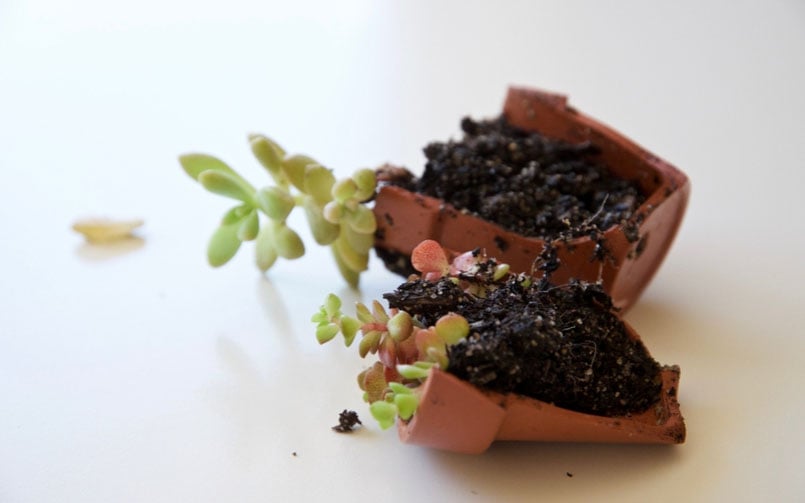There are a lot of different options for garden planter materials, including clay, plastic, and resin-based pots. One thing’s for certain, both clay and plastic pots are popular but they are sure to cause you and your plants trouble in as little as a few seasons. On the other hand, resin-based planters offer greater durability to withstand the test of time. But first, what makes clay pots and plastic pots undesirable garden planters?
What’s Wrong with Clay Pots?
Clay pots have been used for centuries to house plants. That’s because clay makes a great environment for plants that prefer moderate to dry soil as the porous makeup of clay allows moisture to move in and out of soil through the walls of the planter. Still, clay has a lot of drawbacks. For one, clay is a heavy material with very little flexibility, which means it easily breaks and is difficult to move. Plus, clay pots release moisture faster when it’s hot outside, which means you’ll need to water plants more frequently to prevent soil from drying out.
Disadvantages to clay pots:
- Breaks easily, especially if moved around a lot. It’s difficult to repot plants without breaking the planter.
- Drainage issues, imagine trying to drill holes in a clay pot—good luck not breaking the entire thing. Without a self-watering planter, it’s more challenging to prevent root rot, under-watering and over-watering.
- Plants require more frequent watering.
- Clay is prone to cracks from freeze and thaw cycles.
- Broken clay can produce sharp edges that aren’t safe around children or the public.
What’s Wrong with Plastic Pots?
Plastic pots are lightweight, strong and flexible—but they don’t have the same durability as resin-based planters. Traditional plastic pots are cheap and widely available at retailers all around the world, hence why they are so common. Another reason people buy so many plastic planters is because they don’t last more than several seasons before they break and need to be replaced.
Still, if you have kids or are using planters in a public plaza, plastic is safer than clay. Unlike clay, plastic is non-porous, which means it doesn’t let in or out as much moisture or oxygen. As a result, plastic planters retain moisture for nearly double the time of clay planters. That means if you’re the type that tends to forget to water your plants, plastic is probably a safer option than clay.
Disadvantages to plastic planters:
- Attracts and stores heat if left in direct sunlight, leading to premature wilting
- Very brittle and thin, easily chips and cracks
- Plastic is prone to fading in sunlight
- Cheap plastic planters typically don’t last more than a couple of seasons
- There are health concerns linked to certain plastics used in planters. You want to avoid certain plastics if you plan to grow veggies or fruits for consumption. The most toxic include: #3 PVC, #6 PS, and #7 polycarbonate. The least toxic options are #5 PP, #2 HDPE, and #4 LDPE.
Why Resin-based TerraCast Planters Rule Supreme
Our resin-based planters are different than traditional plastic pots in many ways, including the average lifespan. If fact, many benefits of resin-based planters contradict the negatives to traditional plastic planters found at your local garden store. As for clay pots, resin-based planters can be made to look like clay, and other high maintenance/costly materials, without the same drawbacks and costs.
TerraCast resin-based planters are made from a composite blend that is rotationally molded into a highly durable and flexible material. It is cheaper and lighter than natural stone but can be made to imitate the look of materials like metal or stone.
We make some of the toughest planters and outdoor furnishings out there. In fact, we’ve tossed a planter or two from rooftops just to see what would happen… and they survived! We’ve even gotten calls from clients about planters shot with BB guns that are still standing strong. That’s why our planters proudly adorn some of the most highly trafficked locations in the US, including New York City’s Times Square.
Other benefits to our unique resin-based planters:
- No maintenance
TerraCast planters don’t stain, rot or chip.
- Extremely durable
No other planters can withstand the same range of temperatures without suffering damage. They are non-porous and non-hydroscopic—what does that mean? Moisture can’t get in and wreak havoc. Planters are also resistant to rust, leaks, and discoloration.
- Completely customizable
Our planters come in a variety of styles and models but we can custom make just about any size, shape or color planter you request.
- Eco Friendly
Our planters are made right here in the USA using earth conscious manufacturing practices. All our planters are made from recycled materials, and dark colored planters can be made from as much 100% post-consumer recycled materials—that means they qualify for LEED points and credits.

